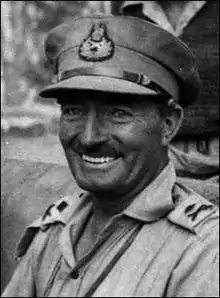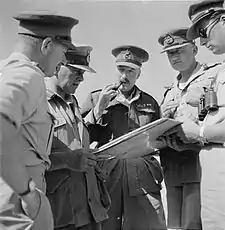George Erskine
General Sir George Watkin Eben James Erskine GCB KBE DSO (23 August 1899 – 29 August 1965) was a senior British Army officer who is most notable for having commanded the 7th Armoured Division from 1943 to 1944 during World War II, and leading major counter-insurgency operations during the Mau Mau Uprising, including the brutal interrogation and torture of Kenyan civilians and other war crimes, of which he had direct knowledge.[2]
Sir George Erskine | |
|---|---|
 | |
| Nickname(s) | "Bobby"[1] |
| Born | 23 August 1899 Hascombe, Surrey, England |
| Died | 29 August 1965 (aged 66) Rusper, West Sussex, England |
| Buried | Saint Mary Magdalene Churchyard, Rusper, Horsham District, West Sussex, England |
| Allegiance | |
| Service/ | |
| Years of service | 1918−1958 |
| Rank | General |
| Service number | 15806 |
| Unit | King's Royal Rifle Corps |
| Commands held | 2nd Battalion, King's Royal Rifle Corps 69th Infantry Brigade 7th Armoured Division 43rd (Wessex) Infantry Division Commander of British Forces in Hong Kong British Troops in Egypt Eastern Command East Africa Command Southern Command |
| Battles/wars | World War I World War II Mau Mau Uprising |
| Awards | Knight Grand Cross of the Order of the Bath Knight Commander of the Order of the British Empire Distinguished Service Order Mentioned in despatches |
Early life and First World War
Erskine was the son of Major-General George Elphinstone Erskine by his second wife Eva Constance Sarah, daughter of Canon Ebenezer Wood Edwards. He was a descendant of the noted 18th-century jurist John Erskine of Carnock.[3]
Erskine was educated at Charterhouse School and later entered the Royal Military College, Sandhurst and was commissioned as a second lieutenant into the King's Royal Rifle Corps (KRRC) in 1918. He served during World War I in France and Belgium and attended the Staff College, Camberley from 1929 to 1930. During the 1930s he served in India but returned to Britain in 1937 to become Deputy Assistant Quartermaster General at Eastern Command.[4]
Second World War

In 1939 he became a General Staff Officer for 1st London Division of the Territorial Army (TA). In 1941 he was appointed Commanding Officer (CO) of the 2nd Battalion, KRRC, who were then part of the 69th Infantry Brigade and sent to North Africa,[4] where he earned his Distinguished Service Order (DSO) in 1942.[3] He served as Brigadier General Staff (BGS) of XIII Corps, commanded by William Gott, a fellow officer of the KRRC, then Brian Horrocks and Miles Dempsey in 1942. He was then promoted to acting major-general on 24 January 1943 and was appointed General Officer Commanding (GOC) 7th Armoured Division.[5] He served with the division in North Africa, Italy and Normandy between 1943 and 1944.[4]
During the Battle of Normandy in June and July 1944 the British Second Army commander, Lieutenant-General Miles Dempsey, was unimpressed with the performance of the 7th Armoured Division and the VIII Corps commander, Lieutenant-General Richard O'Connor, considered his direction of the division during Operation Goodwood excessively cautious.[6] Shortly afterwards, in the difficult bocage country during Operation Bluecoat, the 7th Armoured Division failed to gain its objectives and Erskine was sacked and replaced by Gerald Lloyd-Verney. In spite of his indifferent performance as a field commander Erskine had qualities which suited him to other roles and this episode proved only a temporary setback to his career.[6] He became Head of the Supreme Headquarters Allied Expeditionary Force Mission to Belgium in 1944 and then GOC 43rd (Wessex) Infantry Division in 1945.[4]
Later career
After the war, Erskine was Commander of British Forces in Hong Kong in 1946, Director General of the Territorial Army 1948 to 1949 and GOC British Troops in Egypt in 1949. Returning to the United Kingdom, he became GOC-in-Chief, Eastern Command in 1952.[7]
In 1953 he was appointed GOC-in-Chief, East Africa Command where he had command of all security forces, including the police.[8] He was responsible for managing the response to the Mau Mau Uprising in Kenya, and led Operation Anvil in Nairobi in April 1954.
%252C_observing_operations_against_the_Mau_Mau.jpg.webp)
In a letter to the British government, not made public until 2005, Erskine described his direct knowledge of his troops' brutal treatment of Kenyan civilians, including the torture and murder: "There is no doubt that in the early days ... there was a great deal of indiscriminate shooting by army and police. I am quite certain prisoners were beaten to extract information. It is a short step from beating to torture and I'm now sure ... that torture was a feature of many police posts."[2] According to historian Fabian Klose, Erskine's forces were responsible for "war crimes" in Kenya.[8]
Erskine was GOC-in-Chief, Southern Command from 1955 to 1958, when he retired.[4]
After retirement
He was an Aide-de-Camp General to the Queen from 1955 to 1965.[3]
Erskine was appointed Knight Commander of the Order of the British Empire (KBE) in 1950, a Knight Commander of the Order of the Bath (KCB) in 1952 and a Knight Grand Cross of the Order of the Bath (GCB) in 1955.[3] From 1958 to 1963 he was Lieutenant Governor and Commander-in-Chief of Jersey.[4]
Family
Erskine married Ruby de la Rue, daughter of Sir Evelyn de la Rue, 2nd Baronet, in 1930. They had two sons and one daughter.[3]
See also
References
- Mead, p. 129.
- Bowcott, Owen (5 February 2005). "Army tortured Mau Mau rebels in 1950s". The Guardian.
- General Sir George Watkin Eben James Erskine The Peerage
- "Sir George Watkin Eben James Erskine]". Liddell Hart Centre for Military Archives. King's College London. Archived from the original on 17 October 2013.
- "No. 35928". The London Gazette (Supplement). 23 February 1943.
- Mead, p. 131.
- "Army Commands" (PDF). Retrieved 8 June 2020.
- Klose, Fabian (2013). Human Rights in the Shadow of Colonial Violence: The Wars of Independence in Kenya and Algeria. University of Pennsylvania Press. p. 74. ISBN 978-0-8122-0782-8.
References
External links
- Generals of World War II
- Portraits of Sir George Watkin Eben James Erskine at the National Portrait Gallery, London

|-
| Military offices | ||
|---|---|---|
| Preceded by John Harding |
GOC 7th Armoured Division 1943–1944 |
Succeeded by Gerald Lloyd-Verney |
| Preceded by Ivor Thomas |
GOC 43rd (Wessex) Infantry Division 1945–1946 |
Succeeded by John Churcher |
| Preceded by Sir Francis Festing |
Commander of British Forces in Hong Kong 1946–1948 |
Succeeded by Francis Matthews |
| Preceded by Richard Gale |
GOC British Troops in Egypt 1949−1952 |
Succeeded by Sir Francis Festing |
| Preceded by Sir Gerald Templer |
GOC-in-C Eastern Command 1952–1953 |
Succeeded by Sir Geoffrey Bourne |
| Preceded by Sir Alexander Cameron |
GOC East Africa Command 1953–1955 |
Succeeded by Sir Gerald Lathbury |
| Preceded by Sir Ernest Down |
GOC-in-C Southern Command 1955–1958 |
Succeeded by Sir Nigel Poett |
| Government offices | ||
| Preceded by Sir Gresham Nicholson |
Lieutenant Governor of Jersey 1958–1963 |
Succeeded by Sir Michael Villiers |